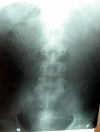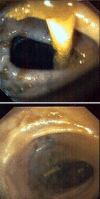Spontaneous bowel perforation complicating ventriculoperitoneal shunt: a case report
- PMID: 19918409
- PMCID: PMC2769419
- DOI: 10.4076/1757-1626-2-8251
Spontaneous bowel perforation complicating ventriculoperitoneal shunt: a case report
Abstract
Ventriculoperitoneal shunt placement is an effective treatment of hydrocephalus diverting the cerebrospinal fluid into the peritoneal cavity. Unfortunately, the shunt devices have a high incidence of malfunction mainly due to catheter obstruction or infection and are associated with various complications, 25% of which are abdominal. Spontaneous bowel perforation is a rare potentially fatal complication of ventriculoperitoneal shunt occurring anytime, few weeks to several years, after the placement of the ventriculoperitoneal shunt device. A 54-year-old Greek man with spontaneous perforation of sigmoid colon as a complication of distal ventriculoperitoneal shunt migration was treated successfully by antibiotic prophylaxis and abdominal surgery. Clinicians managing patients with ventriculoperitoneal shunt must be familiar with its possible complications and be aware for early recognition of them.
Figures




References
Publication types
LinkOut - more resources
Full Text Sources

